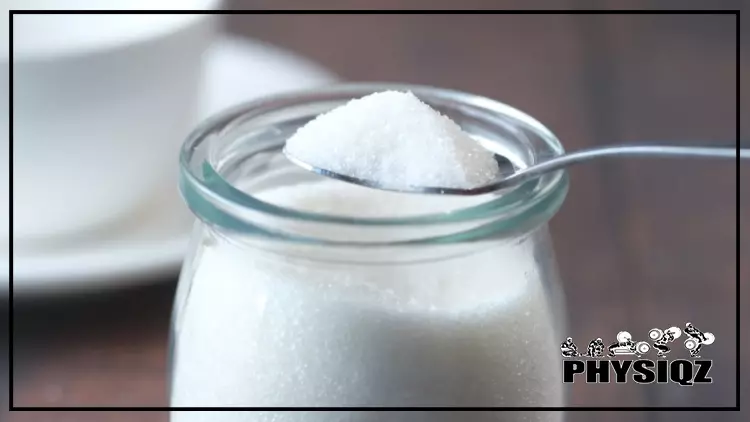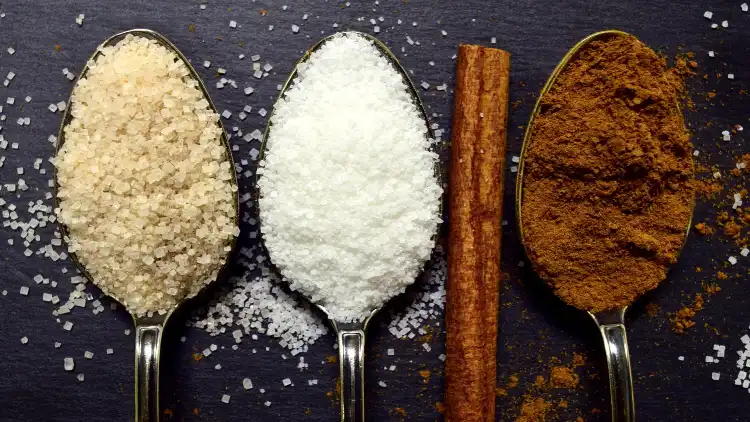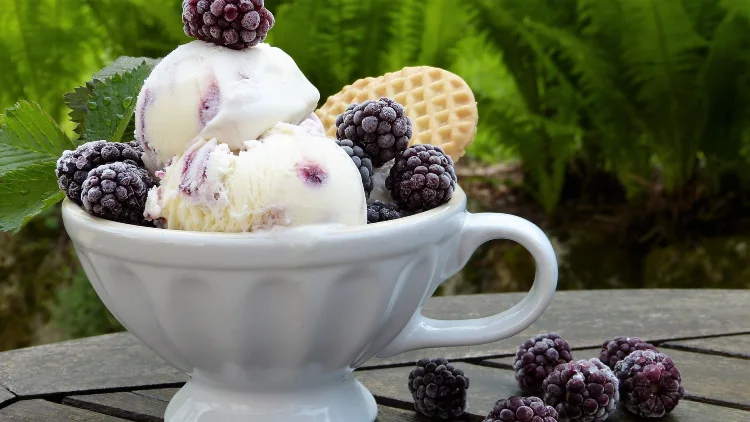
There may be some people wondering if dextrose is keto friendly, or the smallest amount found in some table salt brands kick a dieter out of ketosis.1
For those who aren’t aware, dextrose is a sugar substitute made from corn or wheat and is seen in many processed food, desserts and even in table salt.
And while dextrose is considered low carb, it is not keto friendly because of the high glycemic index; and the same is true for many sweeteners on the market.
Therefore, readers are encouraged to familiarize themselves with the banned keto sweeteners seen below, and to try these keto sweeteners instead.
- Allulose
- Erythritol
- Inulin
- Monk Fruit
- Stevia
- Sucralose
- Xylitol
We’ll cover each keto approved sweeteners pros, cons and glycemic index as well as the best time to consume dextrose, and if the amount found in table salt should be a cause for concern.
Are There Carbs in Dextrose? How Many Carbs Are in Dextrose?
While not quite no-carb, dextrose does qualify as low-carb. Navigating dietary restrictions and adjustments can pose challenges for both beginners trying to lose weight and experienced individuals alike.
In contrast to approaches like intuitive eating for weight loss or other diet plans, keto principles emphasize consuming foods low in carbs and high in fat.
While the body functions on energy from glucose (sugar) and/or fat, following keto requires minimal glucose intake so that the body starts burning fat for fuel. This switch to the body running on fat instead of glucose is called “ketosis.”
While there are carbohydrates in dextrose, there are only 4 grams of net carbs in each teaspoon of dextrose. Therefore, these carbs are not what disqualifies it from being a keto-friendly sugar alternative.
Does Dextrose Have a High Glycemic Index or Spike Blood Sugar?
Dextrose has an extremely high Glycemic Index and drastically elevates blood glucose levels.
The Glycemic Index (GI) gives value to various foods in order to measure how they impact blood sugar levels.
The index spans from zero to 100 with three specific ranges to classify foods as low, medium, or high glycemic. Low glycemic foods have the least influence on blood sugar levels and high glycemic foods have the most impact.
The GI ranges are as follows:
- Low: 0-55
- Medium: 56-69
- High: 70-100
Generally, foods with high levels of sugar and/or carbs will rank on the high end of the GI while fiber, fat, and protein-packed foods will fall lower on the index. Foods completely lacking in carbs do not hold a place on the GI at all.
For dextrose, one may be surprised to learn that dextrose tops the chart at 100–the highest possible rating for Glycemic Index. Therefore, dextrose is not keto.
Dextrose spikes blood sugar immediately and to a very high extent; so much so that it’s commonly used in bodybuilding to refuel and give an immediate energy boost.
There are many factors that go into blood sugar measurements and the amount of time necessary to stabilize after eating. These variables include types of foods and their glycemic levels (as indicated on the GI), ease of digestion, weight, activity level, water intake, and many other factors.2
Depending what is eaten and the variables listed above, blood sugar levels can take up to two hours or more to regulate.
Is Dextrose Keto Friendly? Is Dextrose Good or Bad for Keto?
As dextrose is derived from plants, it can be easy to fall under the impression that it offers more health benefits compared to other sugar substitutes or artificial sweeteners. Many individuals are starting the new year with health and fitness resolutions, joining the trend of top trending diets that actually work, including keto.

Source: ulleo from Pixabay3
One may be surprised to learn that dextrose is not keto.
The ketogenic diet, a leader in terms of both rapid and sustained weight loss, is quite popular.4
However, dextrose does not fall under the umbrella of foods meant to consume while on a keto diet. The low carbohydrate levels in dextrose may lead one to believe that it’s a great sweetener, but the rank of a whopping 100 on the GI knocks dextrose out of the running for keto friendly sugar substitutes.
How Much Dextrose Is in Salt?
Sugar and salt are viewed at opposing ends of the spectrum when it comes to flavors and seasonings, so it may seem like a very strange concept that one could be composed of the other, but there is sugar in salt.
Dextrose is not only keto-unfriendly, a miniscule amount of dextrose is included in the ingredients of salt so some show concern over this. This little bit of dextrose keeps the potassium iodide from oxidizing and subsequently evaporating.5
However, dextrose comprises a mere 0.04 percent of salt and does not contribute much in the way of sugar intake. Anyone cautious of their sugar consumption or following keto rules should use their own discretion when it comes to dextrose in salt.
How Much Dextrose Can I Consume & Not Be Kicked Out of Ketosis?
Exceeding a meager 20-50 grams of carbs per day can already bump someone out of ketosis and with every teaspoon of dextrose, they’re gaining 4 net carbs.
With such a low threshold, it’s recommended to drastically limit dextrose intake if one is trying to remain in a state of ketosis.
However, even individuals striving to lose weight and get thin quickly still crave sweets. Anyone with these cravings might be pleased to know the general consensus is that limiting oneself to small servings and only having dextrose in moderation is acceptable and will not be impactful enough to knock them out of ketosis.
One should stay strictly under 20-50 grams of carbs (preferably less than 5 teaspoons of dextrose), and remember that no dextrose is the safest bet.
Signs of Being Kicked Out of Ketosis
Anyone taking the risk of consuming small amounts of dextrose should be aware of the signs that they’ve been bumped out of ketosis. These signs include:
- Bloating
- Brain fog
- Energy crashes
- Fatigue
- High blood sugar
- Hunger
- Irritability
- Stalled weight loss
- Sugar cravings
What’s the Best Time To Consume Dextrose?
The two main factors influencing the best time to consume dextrose are exercise and whether or not one has diabetes, but several other variables should be taken into account as well.
Low blood glucose–commonly referred to as low blood sugar or hypoglycemia–can vary somewhat depending on age, activity levels, weight, and potential health issues.
Even moreso, the frequency, exertion, and duration of exercise plays a large factor in blood sugar levels.
Above all, those with Type I diabetes and taking insulin or other diabetes medications should be especially cautious and aware of monitoring their blood glucose.
As each person’s body will respond somewhat differently depending on all of the factors mentioned above, it is vital that one learns how their body reacts to these variables. One can heighten awareness by paying attention to their body, recognizing any changes in energy levels or sluggishness, and knowing the symptoms of hypoglycemia.
Symptoms of low blood glucose abound; they include weakness, sweating, clamminess, confusion, noticeable changes in skin color, changes in heart rate, pains throughout the body (especially in legs and calves), abnormal breathing or labored breath, sudden nausea or abrupt onset of headaches.6
While exercising or elevating one’s heart rate, energy is being exerted and used and blood sugar is dropping–sometimes drastically. Many athletes, particularly those following powerlifting and powerbuilding programs, often consume dextrose right after a rigorous workout to quickly restore their blood glucose levels to pre-exercise levels.
Others feel better when they take dextrose just before exercising or weight lifting.
But for optimal intake of dextrose, one should start with planning their meals no more than 3-4 hours apart and completing their workout routine within that window so that they have a replenishing meal both pre- and post-exercise. While there is no cut and dry schedule, this provides a rough window to begin with as one assesses their own ideal timing and routine of fueling, exercising, and then refueling.
With some trial and error, one can determine what works best for them.
For those overwhelmed or stressed about finding the best routine or schedule, it might be relieving to know that keeping to a strict time frame is not as necessary as the dextrose consumption itself.

Source: Sushil Ghimire from Pixabay7
Ensuring one reaches their target for total daily carb intake is more important than precise nutrient timing; instead of obsessing over the exact minute to have a dextrose-packed meal or snack in relation to your workout, simply start out with proper refueling each day and make adjustments as needed to reach peak performance.8
Dextrose & Diabetes
Of course, the primary exception to this is for those who are diabetic and need a more structured routine. While they’ll likely already have a blood glucose monitor, consuming dextrose at the right time is key because sleeping, fasting, alcohol without food and even simply being sick can cause low blood sugar.
Those with Type I diabetes or on insulin or other diabetes medications may want to consider having a dextrose-heavy snack before going out on the town, a long drive, and even before sleeping.
Sugar Substitutes & Sweeteners Not Allowed on Keto
Since dextrose isn’t suitable as a keto-friendly sweetener, you might wonder about other options and what’s allowed in the quest for a perfect body without disrupting ketosis.
The following sweeteners and sugar substitutes are NOT allowed on keto:
- Acesulfame potassium
- Agave
- Agave syrup/nectar
- Aspartame
- Brown sugar
- Cane juice
- Coconut sugar
- Date sugar
- FiberYum
- Fructose
- Fruit juice concentrate
- Glycerol
- Isomalt (unless in very small servings)
- Lactitol (unless in very small servings)
- Maltitol (unless in very small servings)
- Maltodextrin
- Mannitol
- Maple syrup
- Polydextrose
- Saccharin
- Sorbitol
- Sucrose
- Sweet n Low
- Yacon syrup
The 10 Best Keto Sweeteners & Low Carb Sugar Substitutes With a Low Glycemic Index
When it comes to answering if dextrose is ketogenic, most will discover that it is not and consider ruling out other sweeteners and sugar substitutes that are not suitable for keto. Thus, it’s time to delve into the most keto-friendly sweeteners and low carb sugar substitutes.

Source: silviarita from Pixabay9
For those curious about the weight they can lose on a keto diet or following keto guidelines for health reasons, here are numerous sweet options with low Glycemic Index rankings and their potential applications:
Allulose
Calorie-free, GI rank of zero, and 4 grams of carbs per teaspoon, allulose is derived from plants, raisins, and figs. It is a natural sugar and has a similar taste and texture to white sugar.
Allulose is becoming popular in keto-friendly yogurts, ice creams, salad dressings, jams, spreads, breads, muffins and other sweets. It has a clean, sweet flavor profile.
Erythritol
With a GI rank of zero, negligible calories, and only 4 grams of carbs per teaspoon, erythritol tastes fresh and sweet and doesn’t leave the lingering aftertaste that some sweeteners do.
Often mixed with other sugar substitutes to sweeten low-calorie and sugar-free foods and drinks, erythritol can also be used in baking or added to coffee or tea.
Inulin
Although different from others on this list in that it is not necessarily a sweetener, inulin is derived from chicory root and is considered a prebiotic fiber. This may be a great choice for those who don’t want an overly sweet sugar substitute, as it is much more subtle and with less aftertaste
Known to aid in weight loss, easing constipation, and helping the gut to better absorb various nutrients, inulin has an array of health benefits. For mild sweetening, it can be used in coffee or hot tea as well as in baked goods.
Inulin has a zero on the glycemic index and just 4 grams carbohydrates in each teaspoon.
Monk Fruit
With a sugar-like texture, monk fruit (sometimes called monk sugar) is sweet of course, but can also leave that same strange lingering taste. Thankfully it seems to be more subtle than the aftertaste of many other substitutes.
With zero carbs and a zero rating on the Glycemic Index, monk fruit can aid in weight loss and is available in many forms: powder, coarser granules, golden granulated monk fruit, and monk fruit extract. Its uses abound, as it can sweeten hot and cold drinks, smoothies, yogurt, oatmeal, dressings, and so on.
Claims have also been made that monk fruit has antioxidant, anticancer, and anti-inflammatory properties and can be beneficial for those with diabetes.
Stevia
Stevia can be used in small quantities to replace sugar in baked goods, coffee, tea, and other sweet treats. With no calories, carbs, nor artificial ingredients, this is a great alternative and ranks at zero on the GI.
Note: stevia is hundreds of times sweeter than raw sugar, so it should be used sparingly. It can also have an artificial aftertaste.
Sucralose
An odorless white or off-white powder, sucralose is almost sickeningly sweet and should be used sparingly until desired taste is achieved. It is safe to use in cooking and baking and can also be found in canned fruit, soda, pre-packaged candy, and packaged baked goods.
This is yet another keto-safe option as it has zero net carbs and falls at zero on the GI.
Xylitol
Ranking at a mere 7 on the GI and with only 4 grams of carbs per teaspoon, xylitol is an excellent go to. Tasting as sweet as sugar, it doesn’t cause the damage that real sugar does.
In fact, xylitol is commonly found in chewing gum because it actually prevents tooth decay!
It has also been used to fight both ear and yeast infections, ramp up collagen production and even prevent osteoporosis. Those with pets should be cautious though, as xylitol is highly toxic to dogs.
Splenda (Branded Sucralose)
Made from sucralose, Splenda is a branded sugar substitute used in cooking, baking, jello, chewing gum, desserts and commonly available in grocery stores and restaurants to sweeten food and drinks.
While there are many products now marketed under the Splenda brand name, there are many Splenda sweetener options available that have a low glycemic index and zero net carbs.
Swerve (Powdered Erythritol Brand for Baking)
Another brand of sweetener becoming popular in grocery stores, Swerve is a zero-calorie sweetener available in granules or powder. Certified to be non-GMO, Swerve has net zero carbs and has a GI of zero.
Baking or dissolving Swerve into other ingredients helps avoid the coarseness of the crystals or granules. Chilled treats such as ice cream, pudding, cheesecake and homemade whipped toppings are perfect treats to sweeten with Swerve!
Truvia (Branded Stevia & Erythritol)
Combining both stevia and erythritol, Truvia is commercially produced by companies Coca-Cola and Cargill. It can be sprinkled on grapefruit or cottage cheese, used in baking cookies or cakes, or added to drinks for extra sweetness.
Truvia was given a zero on the GI and has net zero carbs. While unsurprisingly sweet, some may notice a subtly bitter aftertaste.
When a recipe calls for sugar but substitutes and artificial sweeteners abound, it can be difficult to discern which is best. People who are diabetic may have different needs or preferences than those with other health issues or those adhering to the keto diet.
In summary, dextrose isn’t suitable for keto diets, but fortunately, there are plenty of keto low carb alternatives to enjoy!
Frequently Asked Questions
Is Dextrose Good for Workouts While on Keto?
No; while dextrose is low in carbs, it holds the highest ranking on the Glycemic Index (100), making it unsuitable for those on keto.
Is Less Than 1% Dextrose Bad for Keto?
While not considered keto-friendly, extremely small amounts consumed infrequently may be okay.
How Is Dextrose Consumed?
Dextrose can come in tablet form, gel chews, as an ingredient in supplements or vitamins, and in many foods such as fruits, crackers, baked goods, and juices.
While most often consumed orally, dextrose that is being used for medical purposes can also be dissolved and administered intravenously to quickly increase blood sugar.
Does Dextrose Cause Side Effects?
Dextrose side effects can include high blood glucose, fluid retention, swelling of extremities, fever, sweating, shortness of breath and feeling faint.
Allergic reactions are also possible and may be signified by hives or welts, breathing issues, and swelling of the face and throat.
Those with Type I diabetes or on insulin and other diabetes medications should consult a doctor before any dextrose consumption or injections.
References
1Towfiqu barbhuiya. “Clear Glass Jar With White Powder.” Canva. Accessed 11 April 2023. <https://www.canva.com/photos/MAE7CpQO1pI-clear-glass-jar-with-white-powder/>
2LeWine, H. E. (2021, November 16). Glycemic index for 60+ foods.Harvard Health Publishing. Retrieved January 4, 2023. Web. <https://www.health.harvard.edu/diseases-and-conditions/glycemic-index-and-glycemic-load-for-100-foods>
3ulleo. “Sugar Cinnamon – Free photo on Pixabay.” Pixabay, 3 January 2018. Accessed 11 April 2023. <https://pixabay.com/photos/sugar-cinnamon-cinnamon-sugar-cute-3057660/>
4Masood, W., Annamaraju, P., & Uppaluri, K. (2022, June 11). Ketogenic Diet. National Institute of Health. Retrieved January 6, 2023. Web. <https://www.ncbi.nlm.nih.gov/books/NBK499830/>
5Wikipedia. (2022, December 27). Iodized Salt. Wikipedia: The Free Encyclopedia. Retrieved January 4, 2023. Web. <https://en.wikipedia.org/wiki/Iodised_salt>
6National Institute of Diabetes and Digestive and Kidney Diseases. (2021, July). Low Blood Glucose (Hypoglycemia). National Institutes of Health. Retrieved January 5, 2023. Web. <https://www.niddk.nih.gov/health-information/diabetes/overview/preventing-problems/low-blood-glucose-hypoglycemia>
7Ghimire, Sushil. “Fitness Gym Exercise – Free photo on Pixabay.” Pixabay, 20 February 2019. Accessed 11 April 2023. <https://pixabay.com/photos/fitness-gym-exercise-workout-fit-4006937/>
8Aragon, Alan A., & Schoenfeld, B. J. (2013, January 29). Nutrient timing revisited: is there a post-exercise anabolic window? National Library of Medicine. Retrieved January 5, 2023. Web. <https://www.ncbi.nlm.nih.gov/pmc/articles/PMC3577439/>
9silviarita. “Free Image on Pixabay – Ice Cream, Blackberries, Milk.” Pixabay, 12 May 2017. Accessed 11 April 2023. <https://pixabay.com/photos/ice-cream-blackberries-milk-sugar-2305159/>